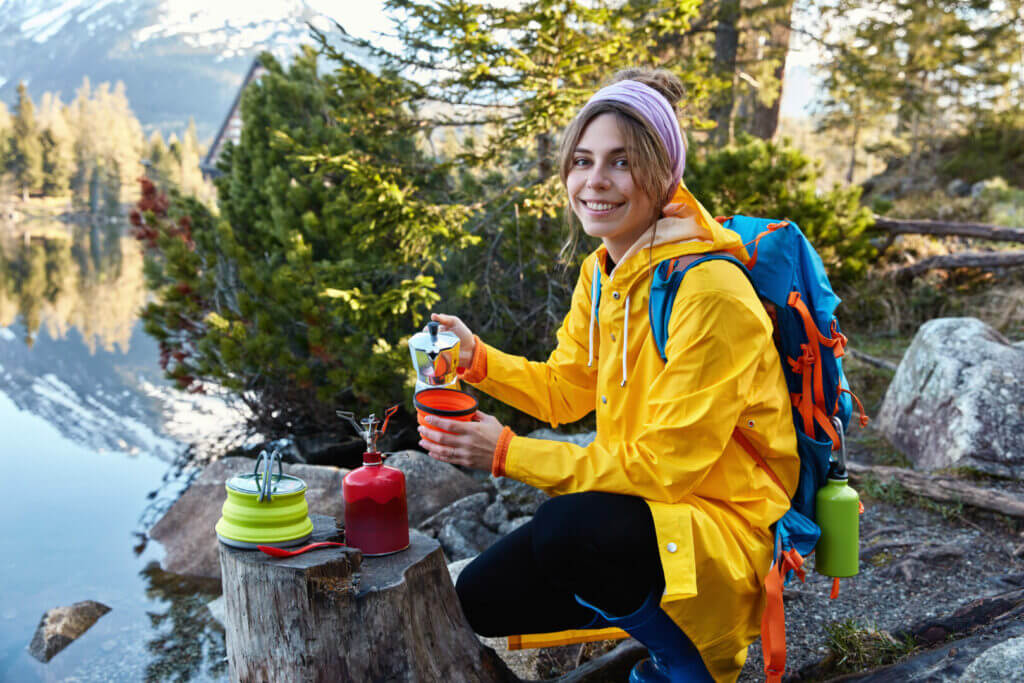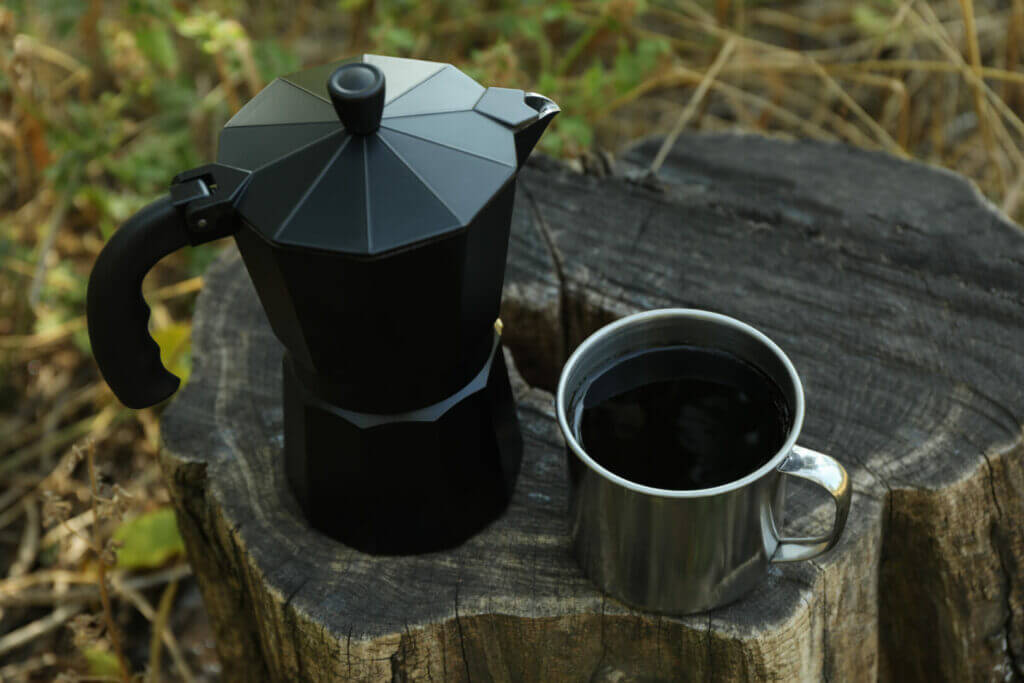Table of Contents Show
There’s nothing like a cup of hot, fresh coffee to help start your day or give you a boost. That’s especially true when traveling the country in your RV and enjoying the great outdoors. But unlike at home, where that standard old coffee maker might work fine, finding the perfect RV coffee maker may require a bit of knowledge and research. Let’s take a look at everything you need to know.

Types of RV Coffee Makers
Before we break down our top picks for your next RV coffee maker, you need to understand the different types of coffee makers out there.
Drip Coffee Maker
Drip coffee makers are the most common. To use them, fill a reservoir in your coffee maker with water. Your machine will then heat and drip the water onto your ground coffee, sitting in a filter. As the hot water saturates the coffee grounds, the coffee brews and drips into a carafe for serving. These user-friendly coffee makers often work best for larger groups rather than a single serving.
Pour-Over
Pour-over coffee makers function by pouring hot water over your ground coffee, which sits in a conical filter. The coffee brews in the filter and then drips through to a receptacle. Depending on the particular design of your coffee maker, it can drip directly into your cup or into a larger carafe for serving a group.
Pour-over coffee makers cannot heat their own water. Therefore, you’ll need another heat source to use them properly. This method also requires some skill and experience, as the quality of your coffee varies depending on the water’s temperature and how it pours.
French Press
The French press is a compact, easy-to-use coffee maker that also requires hot water from another source. To use a French press, fill the carafe with your ground coffee, add hot water, and stir. Allow several minutes for brewing. Then use the plunger-style device in the lid to press the grinds to the carafe’s bottom. The plunger device has a metal screen or filter, leaving pure coffee above. You can then serve the coffee directly from the carafe.
French presses come in many sizes, from those for a single serving to large carafes perfect for groups. Unfortunately, French presses can pose a challenge to clean due to the direct, extended contact between the internal parts and your coffee grounds.
AeroPress
An AeroPress relies on a similar plunging-style method to the French press, but with some modifications. After adding a filter to the AeroPress, you’ll set it over your cup, add ground coffee, and hot water. Using a plunger-style press, you’ll then push down on the coffee grounds and water mixture, which will force the brewed coffee through the filter and into your glass.
To use an AeroPress simply pop open the bottom, discard the filter and compacted coffee grounds, and rinse. As with your French press and pour-over, you’ll need another way to heat your water to use it.
What to Look for in an RV Coffee Maker
When sizing up your next RV coffee maker, you need to consider a few key things that you may not have thought of when you bought your home coffee maker.

Efficiency
You need to consider efficiency when selecting a good RV coffee maker for several reasons. Keep in mind how much electricity it draws to make sure you don’t overload your system. Traditional electric coffee makers can use anywhere between five and eight amps, which can use a considerable portion of your capacity in a 30 or 50-amp RV.
While some models of coffee makers don’t use any power you also need to consider the energy to heat water through another method, whether propane or electric. Having a relatively energy-efficient coffee maker can also prolong your RV battery life when camping off-grid.
Space Saving
RV kitchens don’t have much space. At home, you can shove a bulky coffee maker in the corner on your counter. In an RV, you may need that extra space for food prep or storage. Consider opting for the smallest coffee maker to fit your needs.
Ease of Use
When camping, most people don’t want to spend their time figuring out how to get a good cup of coffee from your new machine. An easy-to-use machine will get you on the road or out enjoying a relaxing morning around the campsite quicker.
Beyond any technological issues, you also need to consider your skill level. Pour-over and some French press coffee makers require some finesse from the operator to produce the best cup. If you want to avoid the hassle when you need a caffeine boost, opt for an easier-to-use method.
Best Coffee Makers for Your RV
With these key factors in mind, we rounded up the best choices for your next RV coffee maker. As we’ve noted, each style has some strengths and drawbacks, so consider your situation and needs when reviewing these picks.

Best French Press for Your RV: Mueller French Press
- Take it Anywhere – Our rust-free french press-stainless steel-is durable for use while camping, at the office, or...
- Robust, Full-Bodied Flavor – This stainless steel french press makes 4 × 8 cup servings of strong coffee. Also use...
Those who love traditional French press coffee may enjoy this sturdy device. The large capacity allows up to 34 oz of coffee per brew (2-4 cups). The double-layered stainless steel walls of your carafe keep your coffee hot for up to an hour longer than other models.
Mueller also uses a custom, four-layer filtration system to avoid finding coffee grounds in your cup. Plus, it’s drop-proof, rust-proof, and dishwasher safe for easy cleaning! And at less than $30, it’s a great value as well.
Best Single Serve Coffee Maker: Hamilton Beach Coffee Maker
- SCOOP YOUR FAVORITE GROUND COFFEE, PLACE AND BREW. Simplify the way you brew by scooping your favorite ground coffee....
- ECO-FRIENDLY AND EASY ON YOUR WALLET. For fresh flavor and less waste, skip plastic pods and paper filters. Since this...
Most coffeemakers require a certain amount to operate. If you travel alone or are the only coffee drinker in your group, you may get frustrated throwing away coffee every time you brew. This Hamilton Beach solves that problem.
It functions as a mini-drip coffee maker, allowing you to brew a single cup in 90 seconds. It’ll even shut off automatically once brewing finishes. This coffeemaker also includes a reusable mesh filter and several options to customize the strength of your coffee.
Best Pour Over RV Coffee Maker: Melitta Pour Over
- Note: 1)Too coarse a grind, too little coffee, or insufficiently tamping the grounds before brewing can all lead to...
- Pour Over and Thermal Carafe Set: Prepare rich, flavorful coffee with this easy to use personal pour-over and thermal,...
For top-of-the-line pour-over coffee, don’t miss this Melitta coffee maker. This set includes a heavy-duty filter cone, an extra supply of cone filters, and a 10-cup insulated stainless steel carafe with a screw-on lid. This allows you to brew larger amounts and ensure your coffee stays hot and fresh for hours.
The brew cone includes full-height ridges and a medium drip opening, reducing bitterness and allowing optimal flavor development. Additionally, this top-rack dishwasher-safe coffee maker makes cleaning a breeze.
Best Drip RV Coffee Maker: Ninja Programmable Coffee Maker
- 2 BREW STYLES: Classic or Rich, each brew is flavorful and never bitter with custom brew strengths.
- 12-CUP GLASS CARAFE: Brew small or large batches of coffee – perfect for day to day or entertaining.
If you want an easy-to-use machine that can brew large batches, opt for this Ninja programmable coffee maker. You can make up to 12 cups in this model with the push of a button, and the removable water reservoir makes filling simple. This coffee maker includes a ton of proprietary technology like an advanced boiler for the perfect hot cup of coffee and a “flavor straw” to circulate coffee through your carafe.
Other features include an adjustable warming plate and a programmable delay-brew feature to get your coffee ready for the following day. It also has various strength settings, and a “small batch” feature if you’re only making a cup or two. This is your most expensive model of our RV coffee maker, at nearly $90. It also takes up the most space. You should also keep in mind your power usage, as this coffee maker draws approximately nine amps of power.
Best for Convenience: Keurig Slim
- MULTISTREAM TECHNOLOGY: Extracts full flavor and aroma in every brew.
- FITS ANYWHERE: Less than 5 inches wide, perfect for small spaces.
When making coffee in your RV, it doesn’t get any easier than just tossing a pod into your coffee maker and letting it do its thing. The Keurig Slim fits easily on your RV counter, at just a foot tall, 5 inches wide, and 15 inches deep.
Still, it provides excellent features like a 46-oz removable reservoir, adjustable cup sizes, and an energy-saving auto-off setting. What it saves in space, it makes up for in power usage. The Keurig Slim uses just over 12 amps of power at its peak, a significant portion of your RV’s capacity.

Making the Perfect Cup
You may find joy in crafting the perfect cup of coffee, and there’s no reason you need to sacrifice quality when traveling with your RV. Whether a coffee connoisseur creating the perfect pour-over cup or a busy parent who needs a one-button caffeine solution, keep these picks in mind. You don’t have to struggle to make good coffee on the road again!
Last update on 2024-12-26 / Affiliate links / Images from Amazon Product Advertising API












Howdy – Love watching and reading about your adventures. I find it interesting that you have a picture of, in my opinion, the best camping coffee pot but you have no mention of it in your article. What are your thoughts of the Moka Pot and why would you have one pictured but not discussed?
Sean
You need to check out Nespresso Vertuo line .. When coupled with Starbucks Sumatra it’s tuff to beat … Beats any other pod coffee hands down .. And I would be amiss if I didn’t think it was on par with a French press .. My personal fav for years .. But for full time in a RV to difficult to deal with mess … Are the pods pricy , yes they are but so worth it .. And the the espresso pods equally great !!!!
Cheers!!!!
In my fifth wheel, I have a Compact Keurig (fits my tall travel mug) and use it with refillable pods when we have hook ups. When we’re off-grid I use a stovetop percolator. Works for us.